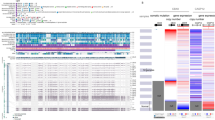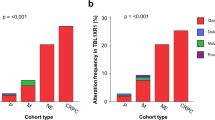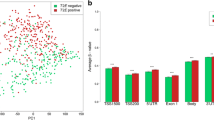Abstract
Deletion at chromosome 16q is frequent in prostate and breast cancers, suggesting the existence of one or more tumor suppressor genes in 16q. Recently, the transcription factor ATBF1 at 16q22 was identified as a strong candidate tumor suppressor gene in prostate cancer, and loss of ATBF1 expression was associated with poorer prognosis in breast cancer. In the present study, we examined mutation, expression, and promoter methylation of ATBF1 in 32 breast cancer cell lines. Only 2 of the 32 cancer cell lines had mutations, although 18 nucleotide polymorphisms were detected. In addition, 24 of 32 (75%) cancer cell lines had reduced ATBF1 mRNA levels, yet promoter methylation was not involved in gene silencing. These findings suggest that ATBF1 plays a role in breast cancer through transcriptional downregulation rather than mutations.
Similar content being viewed by others
References
Berx G, Cleton-Jansen AM, Strumane K, de Leeuw WJ, Nollet F, van Roy F, Cornelisse C (1996) E-cadherin is inactivated in a majority of invasive human lobular breast cancers by truncation mutations throughout its extracellular domain. Oncogene 13:1919–1925
Bieche I, Lidereau R (1995) Genetic alterations in breast cancer. Genes Chromosomes Cancer 14:227–251
Callen DF, Crawford J, Derwas C, Cleton-Jansen AM, Cornelisse CJ, Baker E (2002) Defining regions of loss of heterozygosity of 16q in breast cancer cell lines. Cancer Genet Cytogenet 133:76–82
Chen C, Bhalala HV, Qiao H, Dong JT (2002) A possible tumor suppressor role of the KLF5 transcription factor in human breast cancer. Oncogene 21:6567–6572
Cleton-Jansen AM (2002) E-cadherin and loss of heterozygosity at chromosome 16 in breast carcinogenesis: different genetic pathways in ductal and lobular breast cancer? Breast Cancer Res 4:5–8
Cowin P, Rowlands TM, Hatsell SJ (2005) Cadherins and catenins in breast cancer. Curr Opin Cell Biol 17:499–508
Gronwald J, Jauch A, Cybulski C, Schoell B, Bohm-Steuer B, Lener M, Grabowska E, Gorski B, Jakubowska A, Domagala W, Chosia M, Scott RJ, Lubinski J (2005) Comparison of genomic abnormalities between BRCAX and sporadic breast cancers studied by comparative genomic hybridization. Int J Cancer 114:230–236
Kaspar P, Dvorakova M, Kralova J, Pajer P, Kozmik Z, Dvorak M (1999) Myb-interacting protein, ATBF1, represses transcriptional activity of Myb oncoprotein. J Biol Chem 274:14422–14428
Kataoka H, Miura Y, Joh T, Seno K, Tada T, Tamaoki T, Nakabayashi H, Kawaguchi M, Asai K, Kato T, Itoh M (2001) Alpha-fetoprotein producing gastric cancer lacks transcription factor ATBF1. Oncogene 20:869–873
Kataoka H, Bonnefin P, Vieyra D, Feng X, Hara Y, Miura Y, Joh T, Nakabayashi H, Vaziri H, Harris CC, Riabowol K (2003) ING1 represses transcription by direct DNA binding and through effects on p53. Cancer Res 63:5785–5792
Knuutila S, Aalto Y, Autio K, Bjorkqvist AM, El-Rifai W, Hemmer S, Huhta T, Kettunen E, Kiuru-Kuhlefelt S, Larramendy ML, Lushnikova T, Monni O, Pere H, Tapper J, Tarkkanen M, Varis A, Wasenius VM, Wolf M, Zhu Y (1999) DNA copy number losses in human neoplasms. Am J Pathol 155:683–694
Miura Y, Kataoka H, Joh T, Tada T, Asai K, Nakanishi M, Okada N, Okada H (2004) Susceptibility to killer T cells of gastric cancer cells enhanced by Mitomycin-C involves induction of ATBF1 and activation of p21 (Waf1/Cip1) promoter. Microbiol Immunol 48:137–145
Morinaga T, Yasuda H, Hashimoto T, Higashio K, Tamaoki T (1991) A human alpha-fetoprotein enhancer-binding protein, ATBF1, contains four homeodomains and seventeen zinc fingers. Mol Cell Biol 11:6041–6049
Rakha EA, Armour JA, Pinder SE, Paish CE, Ellis IO (2005) High-resolution analysis of 16q22.1 in breast carcinoma using DNA amplifiable probes (multiplex amplifiable probe hybridization technique) and immunohistochemistry. Int J Cancer 114:720–729
Shibata Y, Miura Y, Tada T, Otsuka T, Asai K, Kato T, Matsui N (2001) Functional analysis of ATBF1, a multiple-homeodomain zinc finger protein, using lung cancer cell line A549. Nagoya Med J 45:31
Sun X, Frierson HF, Chen C, Li C, Ran Q, Otto KB, Cantarel BL, Vessella RL, Gao AC, Petros J, Miura Y, Simons JW, Dong JT (2005) Frequent somatic mutations of the transcription factor ATBF1 in human prostate cancer. Nat Genet 37:407–412
Vos CB, ter Haar NT, Rosenberg C, Peterse JL, Cleton-Jansen AM, Cornelisse CJ, van de Vijver MJ (1999) Genetic alterations on chromosome 16 and 17 are important features of ductal carcinoma in situ of the breast and are associated with histologic type. Br J Cancer 81:1410–1418
Watanabe A, Hippo Y, Taniguchi H, Iwanari H, Yashiro M, Hirakawa K, Kodama T, Aburatani H (2003) An opposing view on WWOX protein function as a tumor suppressor. Cancer Res 63:8629–8633
van Wezel T, Lombaerts M, van Roon EH, Philippo K, Baelde HJ, Szuhai K, Cornelisse CJ, Cleton-Jansen AM (2005) Expression analysis of candidate breast tumour suppressor genes on chromosome 16q. Breast Cancer Res 7:R998–R1004
Widschwendter M, Jones PA (2002) DNA methylation and breast carcinogenesis. Oncogene 21:5462–5482
Yasuda H, Mizuno A, Tamaoki T, Morinaga T (1994) ATBF1, a multiple-homeodomain zinc finger protein, selectively down-regulates AT-rich elements of the human alpha-fetoprotein gene. Mol Cell Biol 14:1395–1401
Zhang Z, Yamashita H, Toyama T, Sugiura H, Ando Y, Mita K, Hamaguchi M, Kawaguchi M, Miura Y, Iwase H (2005) ATBF1–a messenger RNA expression is correlated with better prognosis in breast cancer. Clin Cancer Res 11:193–198
Acknowledgments
This work was supported in part by grants from the National Cancer Institute (grant#CA85560) and from the GA Cancer Coalition.
Author information
Authors and Affiliations
Corresponding author
Additional information
Xiaodong Sun and Yingfa Zhou contributed equally to this work.
Rights and permissions
About this article
Cite this article
Sun, X., Zhou, Y., Otto, K.B. et al. Infrequent mutation of ATBF1 in human breast cancer. J Cancer Res Clin Oncol 133, 103–105 (2007). https://doi.org/10.1007/s00432-006-0148-y
Received:
Revised:
Accepted:
Published:
Issue Date:
DOI: https://doi.org/10.1007/s00432-006-0148-y




